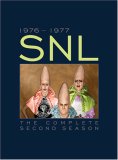| Reviews & Columns |
|
Reviews DVD TV on DVD Blu-ray 4K UHD International DVDs In Theaters Reviews by Studio Video Games Features Collector Series DVDs Easter Egg Database Interviews DVD Talk Radio Feature Articles Columns Anime Talk DVD Savant Horror DVDs The M.O.D. Squad Art House HD Talk Silent DVD
|
DVD Talk Forum |
|
|
| Resources |
|
DVD Price Search Customer Service #'s RCE Info Links |
|
Columns
|
|
|
Saturday Night Live - The Complete Second Season
Still not ready for primetime, but a bit improved anyway
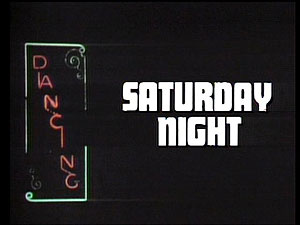 Reviewer's Bias*
Reviewer's Bias*
Loves: Sketch comedy
Likes: SNL, Gilda Radner
Dislikes: Blind worship of the early years
Hates: Those short films
The Story So Far
The granddaddy of all sketch comedy shows, SNL has been a star-maker for a long time, and a destination for insomniacs, drunks and young people looking for some laughs late on the weekend. After decades on the air and countless best-of releases, the series has finally started to arrive in season sets on DVD. The first set was released in November of 2006. DVDTalk has a review here.
The Show
Getting the somewhat-complete first season of SNL on DVD allowed us to slay a few myths about the greatness of the show's revered original cast. The passing of time, the multitude of best-ofs and cut-down syndicated repeats and, in many cases, a cloud of narcotics, created a synthetic, non-existent golden age that recent casts, whose stumbles and failures are fresher in viewers' minds, have been unfairly compared against. It's simply hard to write and perform over an hour of fresh, livesketch comedy, and to get the show on the air, there's going to be some filler and some duds.
Of course, if you're going to gain the reputation SNL at least once had, you've got to get it right at some point. Season Two of the series is where you start to see the genesis of what the show would become, and it all starts in Chevy Chase's crotch. I've never been a big fan of Chase, outside of Fletch and Caddyshack, and his role on SNL, that of an egotistical ass with a limited acting range that falls between smug and more smug, hardly was impressive. Take away his pratfalls and Weekend Update appearances, and I remember just one sketch vividly and that's thanks more to Richard Pryor than Chase.
So when a pratfall in the first episode, part of a debate as Gerald Ford versus Dan Aykroyd's Jimmy Carter, ended with him getting injured in his groin and hospitalized, the show changed, giving more airtime to Aykroyd and Jane Curtin, who took over desk duties for the news segment, Though Chase would return, he left shortly thereafter for Hollywood, and left the show better for it. On Weekend Update, Curtin quickly got comfortable in the anchor role, raising the segment to new heights by playing against female stereotypes, while Aykroyd put his mark on the show with his many versions of the energetic, sleazy archetype. But no one gained more than Bill Murray, who filled the Chase void later in the season, bringing a new dynamic with his slacker style and smartass charm. His characters stood in sharp contrast to the high-strung people portrayed by Aykroyd and John Belushi, and worked well for a late-night series.
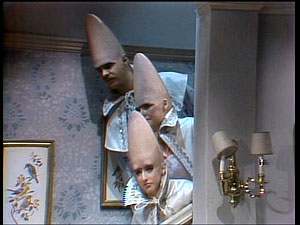 Watching Murray was always preferable to watching Belushi, whose act was an exercise in self-endulgance. Over the years, the screaming, flailing, self-destructive fat man became an SNL stereotype, but it was Belushi who kickstarted the trend, playing several similar characters that somehow caught on, including his samurai, the most enjoyable of the bunch. It wasn't the only character the second season would bring about, as the series discovered the ease of writing a recurring sketch. Larry Farber, Belushi's whining annoyance, returned with his annoying wife, while the Coneheads made their first, second, third, fourth and fifth appearance. Emily Litella, Gilda Radner's hard-of-hearing complainer, frequently bugged Curtin as a Weekend Update commentator, and even got a sketch of her own, with Ruth Gordon playing her sister.
Watching Murray was always preferable to watching Belushi, whose act was an exercise in self-endulgance. Over the years, the screaming, flailing, self-destructive fat man became an SNL stereotype, but it was Belushi who kickstarted the trend, playing several similar characters that somehow caught on, including his samurai, the most enjoyable of the bunch. It wasn't the only character the second season would bring about, as the series discovered the ease of writing a recurring sketch. Larry Farber, Belushi's whining annoyance, returned with his annoying wife, while the Coneheads made their first, second, third, fourth and fifth appearance. Emily Litella, Gilda Radner's hard-of-hearing complainer, frequently bugged Curtin as a Weekend Update commentator, and even got a sketch of her own, with Ruth Gordon playing her sister.
The returning characters aren't limited to the fictional though, as impersonations, of course, are big for the series, with politics and TV providing huge inspiration. The election between Ford and Carter gave the crew decent mileage, while Aykroyd's Carter impression got plenty of screen time upon his election. It was distinctly different from his Richard Nixon impersonation, which fit in well with his creepy roster of characters, or his Tom Snyder impression, which is simply ridiculous, yet terrifically spot-on. In terms of near-perfection, it's topped only by Radner's great Barbara Walter's take-off, Baba Wawa. It's hard to imagine how hard it much have been to maintain that speech impediment, but she did it wonderfully.
Impersonators weren't the only stars on SNL (watch for O.J. Simpson in the audience), as the guest stars ran the gamut, including actors, musicians, politicians, athletes, writers and producers. Among the better hosts this season were Steve Martin, whose legendary appearances started here, Eric Idle, who, like Martin, hosted twice, infusing a definite Monty Python flavor to the proceedings, and politician Julian Bond, whose smoothness in front of the camera shouldn't have been surprising, but was impressive nonetheless. The old stand-bys, Candice Bergen, Lily Tomlin, Buck Henry and Paul Simon, were as dependable as ever, but some of the choices to host were questionable. Jodie Foster was awkward, but OK, while Shelley Duvall could have been replaced by just about anyone. The same can't be said for Broderick Crawford, an old TV veteran, who sat in an armchair between scenes. I'm sure he was a fine actor in his age, but he was a severely bad fit for the show's youthful spirit, even if he did play along.
That youthful spirit, and the subversive comedy the show became known for, really kicked in this season, with a dark sense of humor that started battling with the sillier segments for the series' soul. Sketches about suicide, Christmas carols about capital punishment and pedophiliac rants represented a different kind of SNL, one that really didn't care what you think. Frequently slipping into meta jokes about the show, with Belushi interrupting sketches to take the jokes in a different direction, different was desirable to the show, leading to appearances by oddball comic Andy Kaufman and magician Ricky Jay. Different also meant that you could say almost anything, and frequently did, especially if it was even remotely racist. Now, I don't think the show was racist really, but boy did they enjoy their freedom of speech, taking advantage of the presence of Garrett Morris to crack any number of jokes about black quarterbacks, light-skinned black people and "a warm place to go to the bathroom."
Speaking of black quarterbacks and political incorrectness (a segue I've been waiting to use for years,) the Fran Tarkenton episode is a perfect example of why this series is a great time capsule. There's no way in hell a player would be allowed to jokingly explain why black quarterbacks don't succeed, but even less likely is the cereal commercial parody that sees Tarkenton eat anabolic steroids. Hell, the networks are so uptight that half the Jodie Foster episode wouldn't make it to the air, thanks to her age. It's not as if the show tried anything that daring though, in retrospect, sticking mainly to TV parodies. The edgiest moment you could really find is a bit about a rape counseling hotline for rapists, as part of a sketch about the chauvinist movement, but a few lines in 24 hours of TV is not very much.
Of course, edgy comedy is not the only reason people tuned in to watch SNL, as the series became well-known for the live musical performances, from a mix of big names and up-and-coming bands. But anyone who's watched even a handful of the series' reruns can tell you there were quite a few question marks on the bill. And if you're not into disco or light-FM music, this season didn't hold much for you. Frank Zappa and Joe Cocker's odd performances are memorable, Paul Simon and George Harrison's duets are terrific,and Chuck Berry, the Kinks and Santana performed quality rock, but there are too many acts like The McGarrigle Sisters or Joan Armatrading, for mainstream music fans. There's no one on this set you could call bad, but acts like Donnie Harper & The Voice of Tomorrow and Richard Baskin hardly inspire fandom, though sometimes you'll catch an odd gem, like doo-wop singer Kenny Vance tackling salsa music or Kinky Friedman being Kinky Friedman.
For some reason, while improvements were made in several areas of the show, the series' weakest link, outside of the incredible length of some of the sketches and the 1 A.M. dramas, remained in place: the films (though we are teased with the possible return of the god-awful muppets from Season One.) This season, Gary Weis (future director of The Rutles: All You Need Is Cash) took over behind the camera, but, for the most part, the results were still the same, as if he wasn't even attempting to make a comedy. The home movies solicited by the show weren't any better, though they did introduce the well-known claymation cartoon Mr. Bill. The only filmed bits that were enjoyable were the Rutles film shown during the Idle episode, the George Harrison videos (prequels of sorts to his most famous video), and the commercials, like the one for the rock cereal Quarry or the Marines. Oddly, the ads often are repeated during the season, for some unknown reason. They certainly weren't good enough to deserve it.
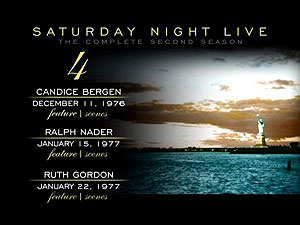 The DVDs
The DVDs
After getting the packaging just about perfect with Season One, someone decided a change was in order, one that resulted in a decidedly cheaper-feeling set. First off, the thick plate on the inside of the cover, which featured a cast photo and helped hold the set closed, is gone. The photo remains, but now the flap just hangs loose. The notch that helps you get the DVDs out of the well they are kept in has switched sides, as the spine has now been glued to the well, for some reason that's not easily discernible, while the whole thing feels flimsy compared to the previous set. As a bonus, instead of using the usual rubbery goo used to hold the sell sheet to the back of the package, a heavy-duty adhesive was applied, eating a lovely groove into the case. Doesn't anyone think about these things?
Once again, the eight DVDs are packaged in a four-tray digipak (overlapped two per tray) featuring an episode listing and a space in the middle for a bonus scrapbook. The discs have animated full-frame menus that have a choice of episodes or scenes, and extras if applicable. There are no audio options and no subtitles, but there is a closed captioning track, but it didn't work on my players.
As far as whether these episodes are edited in any way, it's unclear, though the bumper photos, with the exception of the final one, are once again missing. I followed along with old episode guides where available and didn't notice anything out of place, but I don't have tapes of the original broadcasts for comparison. I'm sure if there are any problems, the fans will make them known.
The Quality
I'm not sure what happened between seasons, but this set looks terrific, at least when it comes to the in-studio video. Sure, it's got an aged look to it, like it's covered with a light film, and any special effects or graphics attempted are terrible, but the color is relatively solid, the level of detail is very high and the image is incredibly clean, free of any noticeable dirt or damage. A bit more contrast and a bit less smearing on the color and this would be gorgeous. As far as the films go, though, they can be rather rough, with lots of dirt in the transfers, distracting banding and coloring that's a bit washed out.
The audio is presented as Dolby Digital 2.0 tracks, which are pretty clean, though there are some problematic moments, most noticeably during the Jodie Foster episode, when the audio gets a bit squeaky and electronic. Overall though, this is an appropriate delivery, and the musical guests sound very nice.
The Extras
The extras are once again pretty slim, starting with a screentest by Andy Kaufman. During the four-minute clip, Kaufman delivers a dramatic performance of "MacArthur's Park," twice, at the insistence of an off-screen voice, and then his take on the old Superman introduction. It fits his sense of humor, but it's just not that funny. What is interesting about it, though, is his wide-eyed glee between performances. One wonders if this was a try-out for the cast, or for his eventual appearances on this show.
Two dress sketches are included, in the form of audio clips (Why not video? No explanation is provided.) First up is "Farbers New Kid," with Spacek, Belushi, Murray, Aykroyd and Radner, followed by a Susie & Shari sketch with Tomlin and Newman. I'm not sure why, but I just couldn't get into these clips and neither did much for me. Their value is purely as historical items.
More interesting is the "SNL Mardi Gras Special," which hasn't been seen on TV since its original airing in 1977. Broadcast live from New Orleans on a Sunday, it's always been claimed that a disruptive Mardi Gras crowd is the reason the episode has been kept under wraps. After watching it, it's more likely the quality of the show itself is why he haven't seen this before. Musical guest Randy Newman is not a problem, performing several enjoyable songs, and Eric Idle makes a fun cameo, but the odd structure of the special, including Buck Henry and Curtin as parade analysts, and Cindy Williams and Penny Marshall reporting uncomfortably from the Krewe of Apollo Ball, keeps the laughs to a minimum and the momentum non-existent. Wedging in the stupid "Antler Dance" makes the whole thing feel manufactured, while tech problems killed several jokes. Overall, it was a mistake, but getting the chance to finally see it is appreciated.
Like last season, this set includes a 36-page scrapbook, featuring the photos of Edie Baskin. The inclusion of several pieces of correspondence related to the show, including telegraphs and postcards, makes it a great look at the show's history, and a fun, short read.
There are also a pair of trailers.
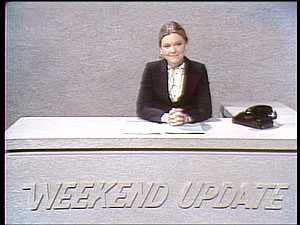 The Bottom Line
The Bottom Line
On a whole, there are more entertaining sketches found in this set than in the first, and several of the hosts set the bar for guest stars, but the music is aimed at a very specific audience, and there is still a very lackadaisical sense of humor that results in overlong sketches and bits that feel more self-indulgent than funny. That there are many jokes that couldn't be told on TV today, including some surprising scenes from the Fran Tarkenton episode, makes the set a fascinating historical document, while the very dated, and frequently cheesy, concepts and references to the time period could make younger viewers feel a bit left out. While the packaging has taken a hit, the discs look great, and sound solid, while the extras are decent and improved from the previous collection. The show may not live up to the memories of its fans, but with this season, it's on the upswing, and there's a lot to enjoy.
Francis Rizzo III is a native Long Islander, where he works in academia. In his spare time, he enjoys watching hockey, writing and spending time with his wife, daughter and puppy.Follow him on Twitter
*The Reviewer's Bias section is an attempt to help readers use the review to its best effect. By knowing where the reviewer's biases lie on the film's subject matter, one can read the review with the right mindset.
|
| Popular Reviews |
| Sponsored Links |
|
|
| Sponsored Links |
|
|
| Release List | Reviews | Shop | Newsletter | Forum | DVD Giveaways | Blu-Ray | Advertise |
|
Copyright 2024 DVDTalk.com All Rights Reserved. Legal Info, Privacy Policy, Terms of Use,
Manage Preferences,
Your Privacy Choices | |||||||









